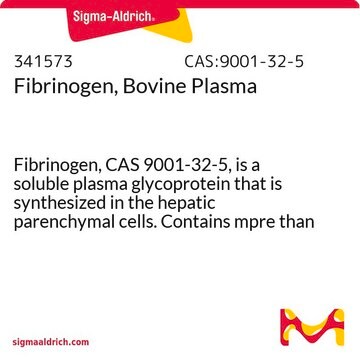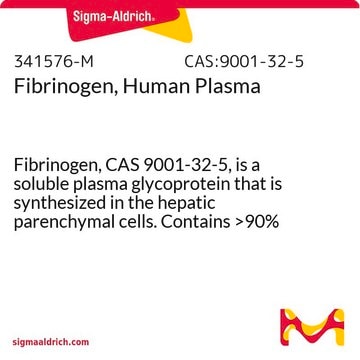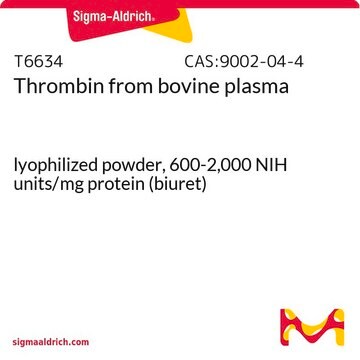F6755
Fibrinogen from rat plasma
60-80% protein (≥60% of protein is clottable)
Sinonimo/i:
Factor I
Scegli un formato
Scegli un formato
About This Item
Prodotti consigliati
Origine biologica
rat plasma
Livello qualitativo
Stato
powder
Qualità
60-80% protein (≥60% of protein is clottable)
PM
α-chain 63.5 kDa
β-chain 56 kDa
γ chain 47 kDa (about 4% carbohydrate content)
soluble dimer 340 kDa
Concentrazione
60-80% (biuret)
tecniche
cell culture | mammalian: suitable
immunoblotting: suitable
Temperatura di conservazione
−20°C
Informazioni sul gene
rat ... Fga(361969) , Fgb(24366) , Fgg(24367)
Applicazioni
- in the preparation of growth factor solutions[1][2]
- to apply on discontinuous SDS-polyacrylamide gels for the detection of IgG (immunoglobulins) type antibodies by immunoblot analysis[3]
- to mix with cell suspension to form a clot and retain the cells for avoiding its dispersion during transplantation[4]
Azioni biochim/fisiol
Qualità
Risultati analitici
Codice della classe di stoccaggio
11 - Combustible Solids
Classe di pericolosità dell'acqua (WGK)
WGK 3
Punto d’infiammabilità (°F)
Not applicable
Punto d’infiammabilità (°C)
Not applicable
Dispositivi di protezione individuale
Eyeshields, Gloves, type N95 (US)
Scegli una delle versioni più recenti:
Certificati d'analisi (COA)
Non trovi la versione di tuo interesse?
Se hai bisogno di una versione specifica, puoi cercare il certificato tramite il numero di lotto.
Possiedi già questo prodotto?
I documenti relativi ai prodotti acquistati recentemente sono disponibili nell’Archivio dei documenti.
I clienti hanno visto anche
Filtri attivi
Il team dei nostri ricercatori vanta grande esperienza in tutte le aree della ricerca quali Life Science, scienza dei materiali, sintesi chimica, cromatografia, discipline analitiche, ecc..
Contatta l'Assistenza Tecnica.











